What is Organization Design?
Organization Design is not a collection of facts; it is a way of thinking about organizations and how people and resources are organized to collectively accomplish a specific purpose. This is a definition of Organization Theory by two Organization Scholars Royston Greenwood and Danny Miller that lends well for adopting for Organization Design. Richard Daft, the author of Organization Theory and Design describes it as a way to see and analyze organizations more accurately and deeply based on patterns and regularities that have been identified, defined, measured and made available to the public, by organization scholars. These are general patterns and insights into how organizations function that were gained from comparative study of organizations.
Some of the general patterns and insights that have developed over the years include the structural dimensions or principles of organizations, the contingency factors that influence the structural dimensions, and the different stages of maturity that organizations encounter during growth, including some common hurdles in each phase.
This article is going to discuss the insights of organization design, the importance of why a Chief Operating Officer (COO) needs to understand it, and how a COO can orchestrate the process.
Key Structural Dimensions (Principles)
The study of organization management theory began in the late nineteenth and early twentieth century. Since then it has matured, expanded and produced insights that are considered foundational to organization design. Some of these foundational insights are the key structural dimensions that serve as lenses through which to view organizations:
- Formalization
- Specialization
- Hierarchy of authority
- Centralization
Formalization
Formalization refers to the amount of written documentation in the organization. Documentation may include processes, manuals, policies and etc. This also corresponds to how well the organization retains information when people leave. If a key person leaves, does the information leave with them or is it documented somewhere? Organizations with a lot of documentation are considered formal and organizations with few or no documented processes or procedures are considered informal.
Specialization
Specialization, sometimes referred to as the division of labor, or the decomposition of an organization, is the degree to which tasks are divided into separate jobs. In an organization that has a lot of specialized tasks each employee only performs a narrow range of tasks. The contrast is a generalist environment where the tasks are grouped in a manner that allows one employee to have a broader range of involvement in the organization.
Hierarchy of authority
Hierarchy of authority refers to how authority and decision-making within an organization, is defined, and this is typically depicted by the vertical layers of an organizational chart. It shows the levels of authority and responsibility, with higher levels having more authority and lower levels having less authority. It also represents the formal chain of command in an organization. Some organizations have a tall hierarchy with many layers of authority, and some have flatter structures with fewer levels of authority and more emphasis on teamwork.
Centralization
Centralization refers to the extent to which decision-making authority is concentrated at the top or held by a few individuals in an organization. It specifically relates to where the decision-making power resides within the hierarchy of authority. In a centralized organization, decisions are made by a small group of people or a single individual at the top, while in a decentralized organization, decision-making authority may be distributed across different levels or departments.
Contingency Factors
Structural Dimensions can be viewed as the core characteristics that can be used to make a decision about an existing organization. Understanding structural dimensions is a good start because you can label the “whats” about an organization. However this does not take into consideration the level of analysis and work it takes organizations to manifest itself in those dimensions. Understanding the analysis that was done to get to that is integral to appropriately design organizations. This analysis is done through another set of insights called contingency factors.
Contingency simply means one thing depends on another, and for this application it means the degree to which the organization favors one extreme of the structural dimensions from the other extreme. The contingency factors are:
- The Organization’s Size and Lifecycle
- The Organizational Technology
- The Organization’s External Environment
- The Organization’s goals and strategy
- The Organization’s Culture
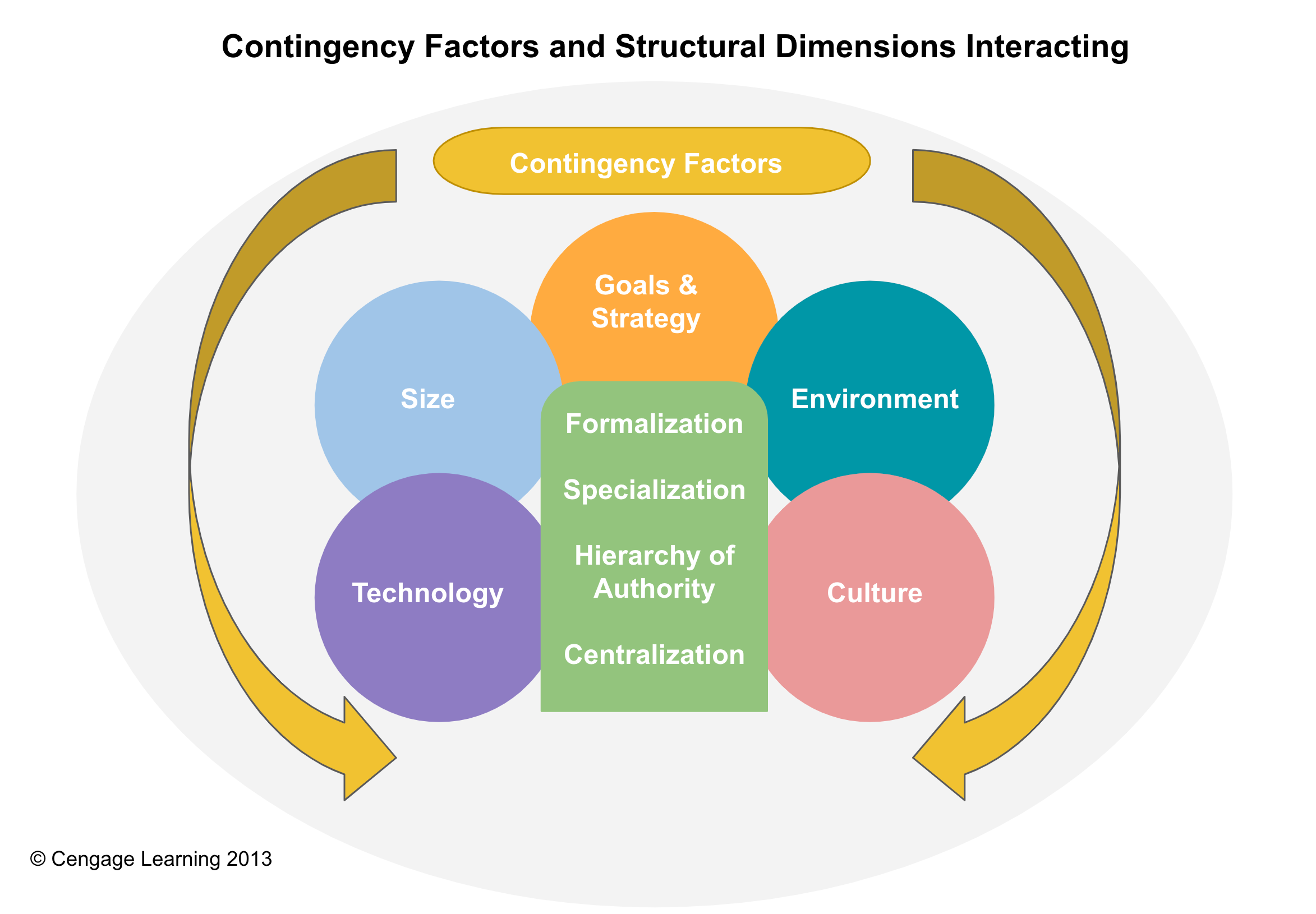
Size
Size refers to the number of employees in the organization. Typically, not always, complexity is introduced as the total number of employees in the organization increases. Other measures such as total sales or assets often reflect magnitude rather than complexity. Therefore, it is possible for an organization of five people to have equal sales and asset values as an organization of 150 people. The normalizing factor for the size organizations are the number of employees.
Lifecycle
Lifecycle refers to an organization’s maturity. Organizations grow, and as they enter new phases, they encounter new complexities and requirements that weren’t in the previous stage. Understanding the phases can help identify design requirements that are essential for success.
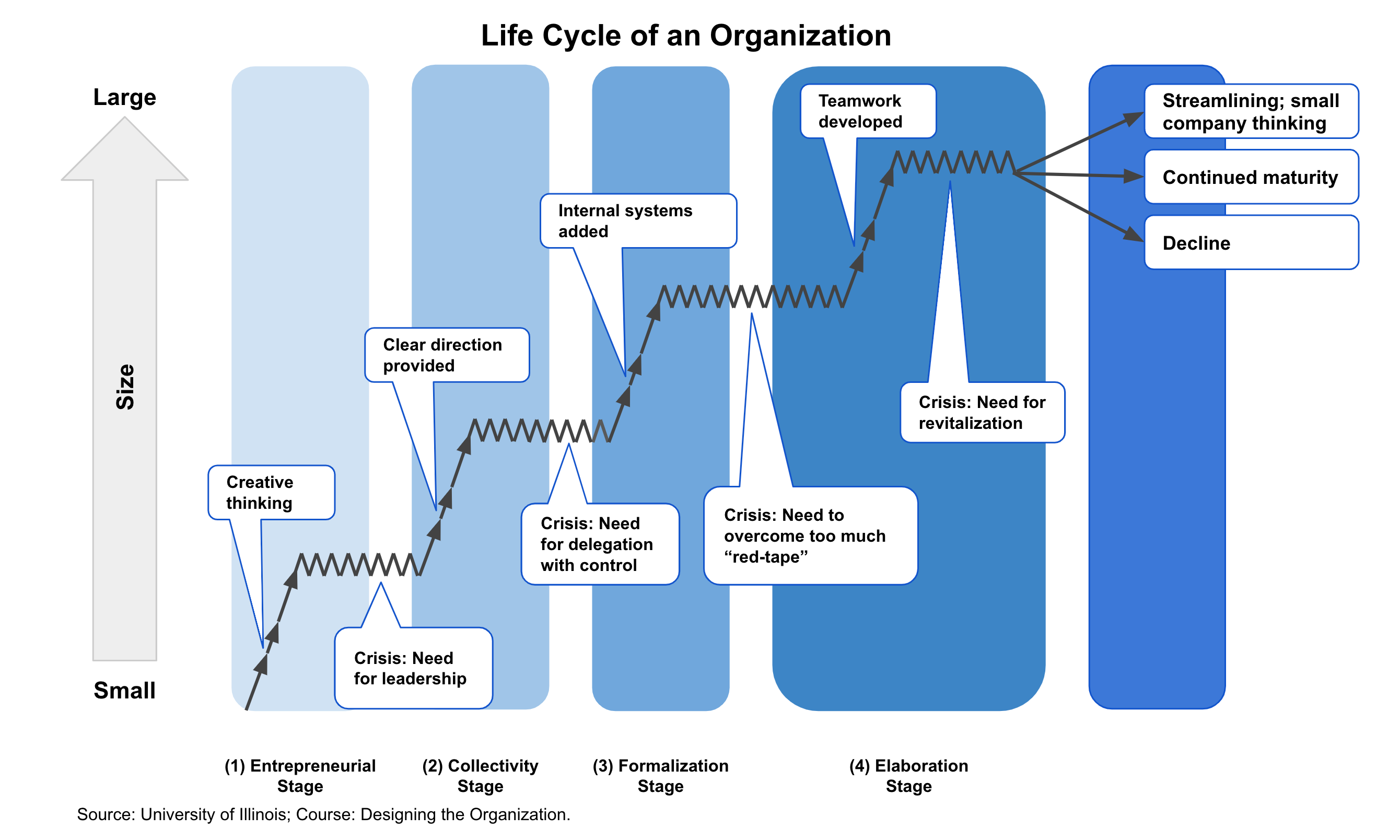
Organizational Technology/Value Chain
Organizational technology/Value Chain is a general term that refers to the tools, techniques, processes and actions used to transform inputs into outputs. It focuses on the value chain of the organization, specifically how the organization actually produces the products/goods and services it provides for customers. This may include information technology, an assembly line for products, a review and analysis process for service based businesses, or a logistics & distribution chain for delivery businesses.
External Environment
The external environment are the elements outside the boundary of the organization; things that are not internal. A few key elements include the government, customers, suppliers, the economy, and other organizations in industry. This influences the competitive landscape of the industry in which the organization functions.
Goals and Strategy
The organization’s goals and strategy are what set it apart from other organizations. This is important because it establishes the company’s purpose and its plan to achieve the purpose. i.e. Goals and strategies define the scope of operations and the relationship with employees, customers, and competitors.
Culture
An organization’s culture are the intangible glue that binds the organization’s members together. They are unwritten values, beliefs, understandings, and norms shared among employees within the organization. This can manifest itself in how employees engage with one another, customers, and the physical office space.
Why a COO needs to understand organizational design principles and process
Thus far this article has discussed four structural dimensions and five contingency factors. These nine insights are interdependent of one another and integral to the organizational design process. Certain contingency factors will influence the appropriate degree of specialization, formalization, and so forth for the organization. For example, small organization size, with customized service delivery technology, and an unstable environment may tend to create an organization that is more agile, adaptive and focuses on collaboration; . The other extremes of the contingency will produce an organization that is more rigid, yet efficient and specialized.
Some COO’s are going to be involved in re-design process rather than an initial design process, however, the same organizational design principles apply for organizational re-design. A COO needs to understand this because it is a holistic approach that can be used to help the organization meet it’s goals and fulfill its purpose.
Organization design analyzes the organization from two levels of influence: (1) the other external organizations in the environment, and (2) the internal business units within the organization. To lead and operate the organization effectively, the COO should understand it’s external competitors and the internal social systems of the organization.
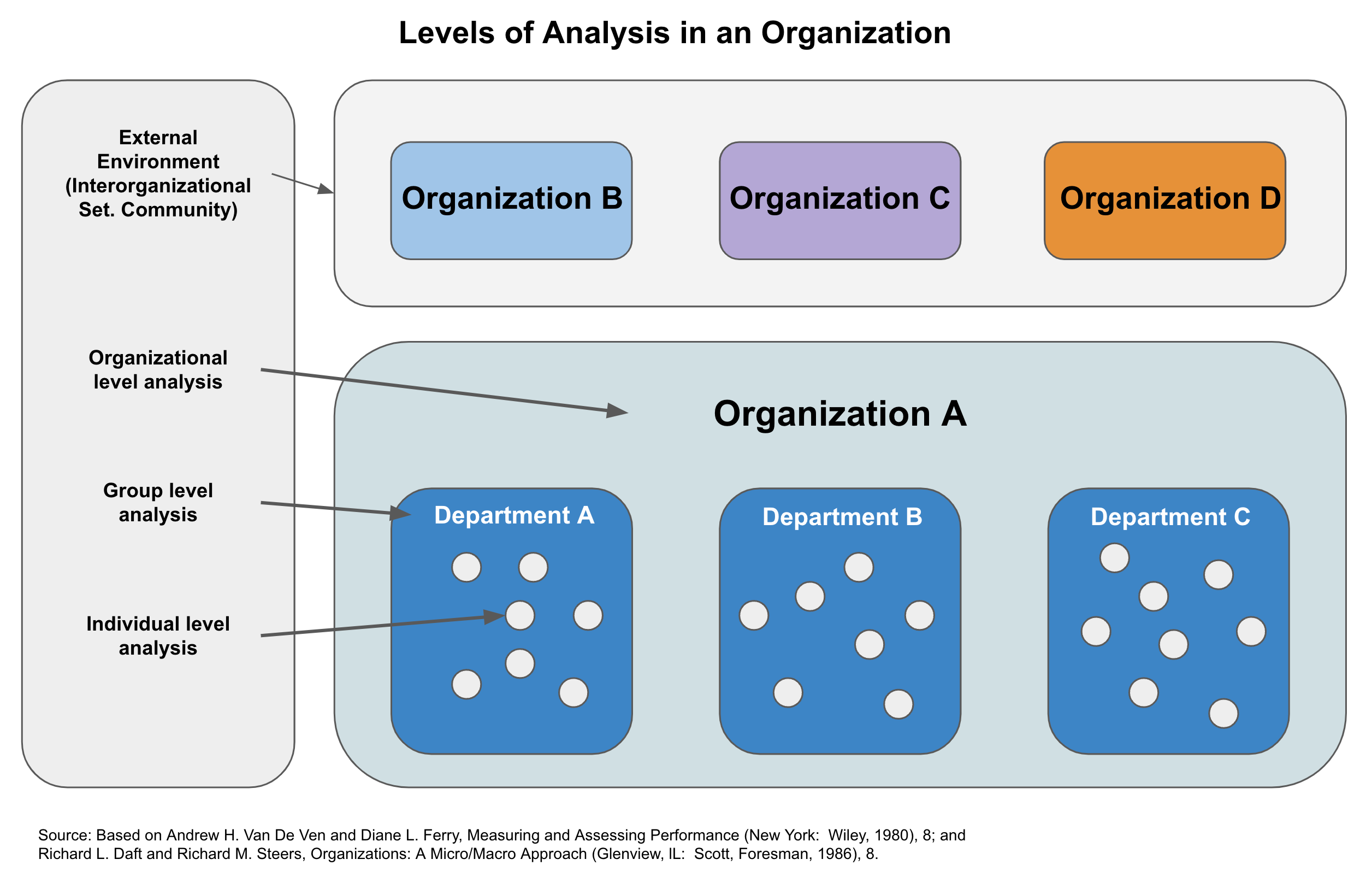
For elaboration below are a few things that the COO is responsible for that could benefit from understanding organizational design principles are:
- Organizational transformation; Small or large scale reorganization
- Planning for future challenges
- Defining and measuring effectiveness
Organizational Transformation
Understanding the structural dimensions and the contingency factors of organization design will help the COO baseline the organization against the established goals and to build a roadmap leading to the most effective organization design to achieve the organizations goals. This is essentially organization change management.
Planning for Future Challenges
As organizations change and grow, there are “typical” challenges and hurdles that the organizations face which are specific to each stage of its growth. Organization design helps the COO develop a plan for the anticipated organizational design challenges.
Defining and Measuring Effectiveness
Effectiveness is the degree to which an organization meets its goals. This is unique to each organization, however, it should not be unique to each individual in the organization. Organization design creates an opportunity for the COO to lead the conversation on how effectiveness will be measured and to confirm all stakeholders agree.
How a COO can use Organizational design
Each contingency factor and structural dimension can be viewed on a continuum or a sliding scale with extremes. An organization’s design, which is an aggregate of the contingency factors and the structural dimensions can itself be viewed on a continuum. As a result, two fundamental approaches to Organization design have developed. At one extreme of the organization design continuum is the mechanistic deign and at the other extreme is organic design.
Mechanistic Design
As a representative simplification, a mechanistic design means that the organization is characterized by machine-like standard rules, procedures, and a clear hierarchy of authority. Organizations with mechanistic design are highly formalized and are also centralized, with most decisions made at the top. A lot of things are impersonal to the employee and the system is built so that an employee is a “cog in the wheel.”
Organic Design
In contrast, an organic design means that the organization is much looser, free-flowing, and adaptive. Rules and regulations aren’t written, and are applied with discretion and flexibility. People may have to find their own way through the system to figure out what to do. The hierarchy of authority is looser and unclear. Lower level employees are empowered to make more decisions on behalf of the company.
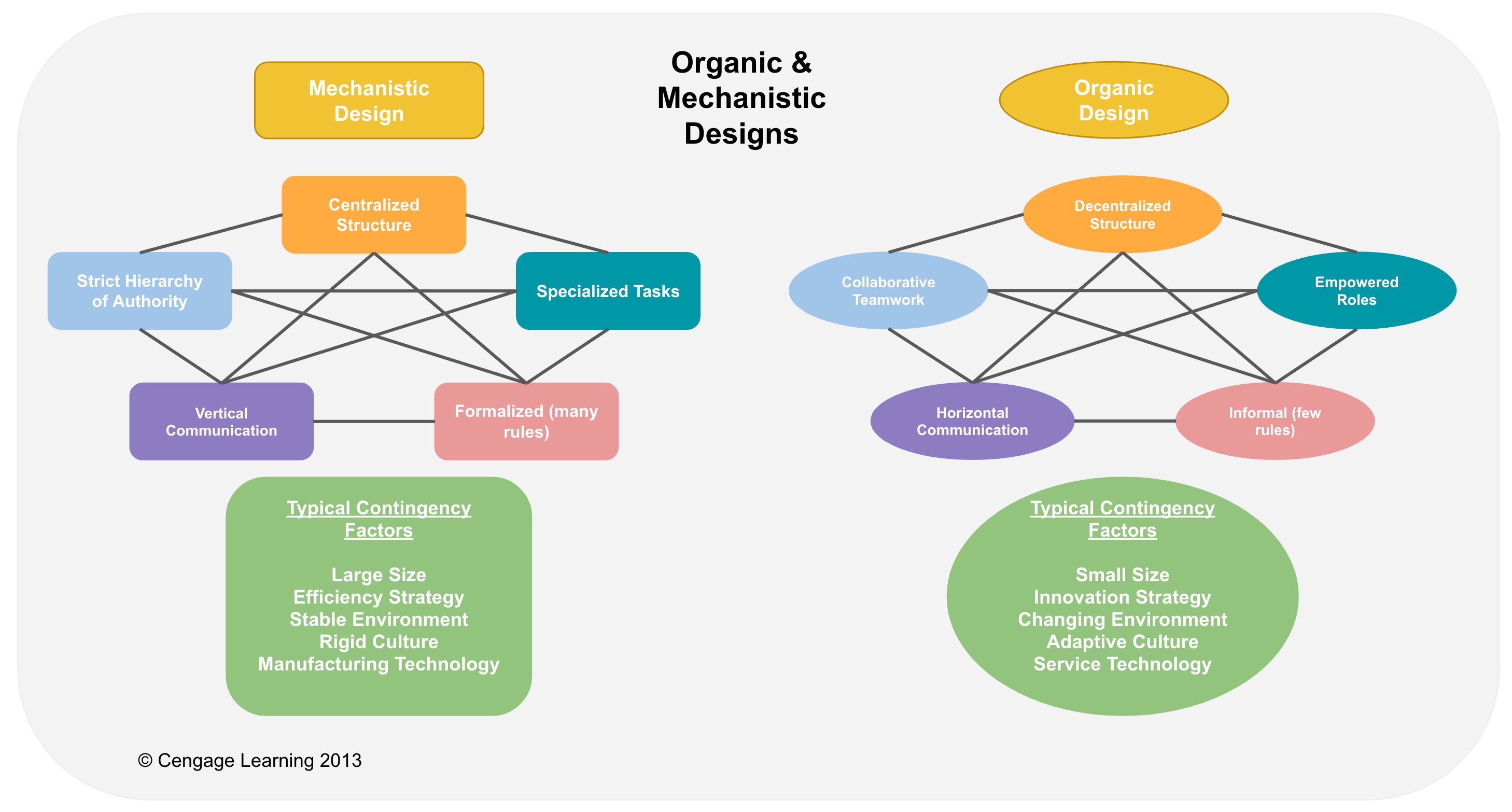
Using the Mechanistic and Organic Design Structures as a guide as a COO
Understanding that the Mechanistic and Organic design structures are extremes of a sliding scale between rigid and flexible, the COO can use this insight as a guide for identifying the current design of his or her organization and develop a road map for creating the most effective organization to allow the company to achieve its goals. As an example it is generally understood that the mechanistic organizational structure works better in organizations where efficiency (eliminating waste of resources) is important and the organic organizational structure works better for organizations designed for flexibility, differentiation and, or adaptation.
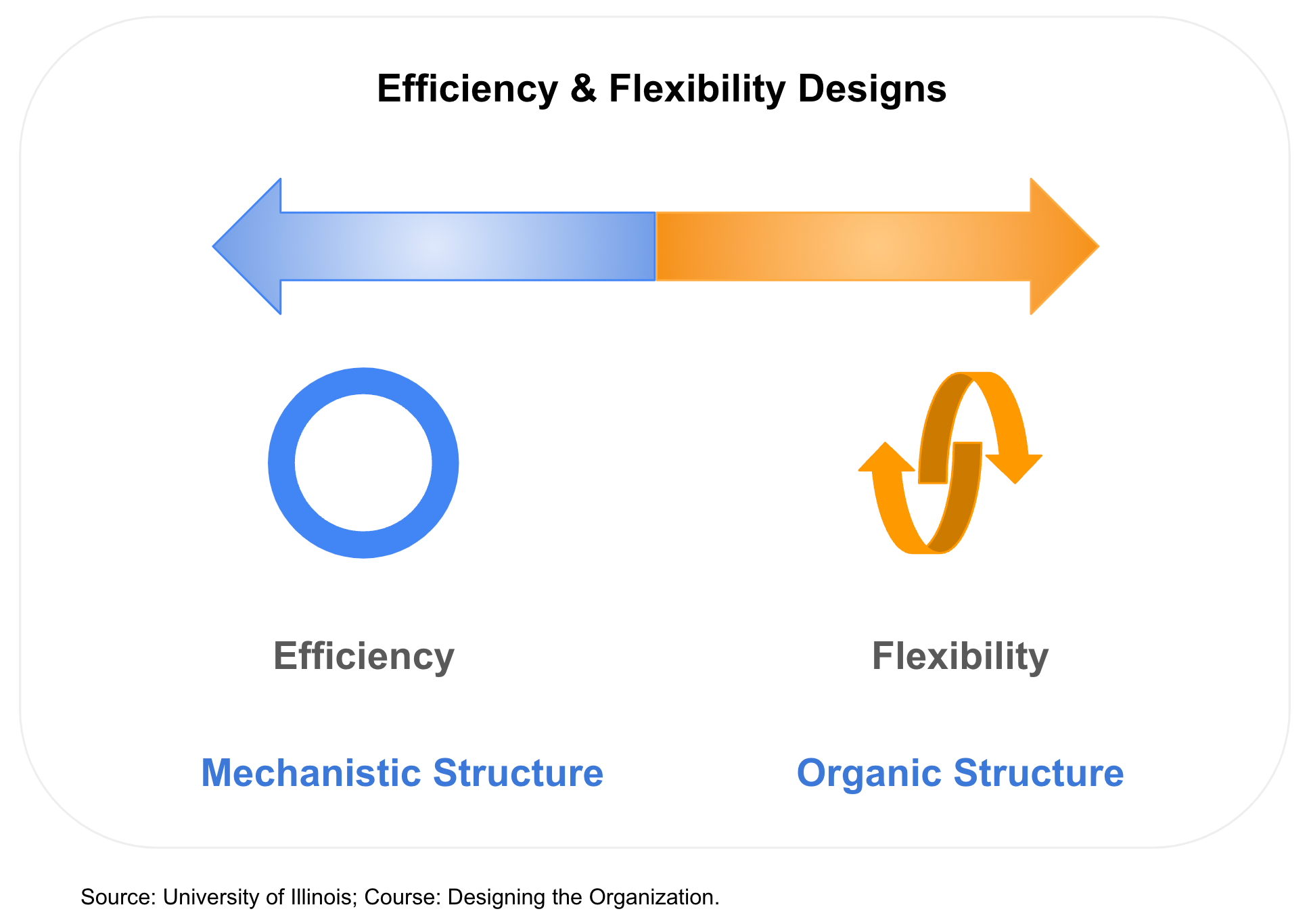
Formal versus Informal System
A mechanistic design, has a lot of written rules, regulations, and standard procedures. These formal systems, are in place to help manage information, guide communication, and enforce quality control. An organic design has fewer rules or formal control systems. Communication and information sharing is informal. Each style works better for different goals.
Specialized Tasks versus Generalized Empowered Roles
A mechanistic design, will have tasks broken down into specialized, separate parts with each employee doing a specific and well defined tasks that is often outlined in a job description. A role, in contrast, empowers the employee to use more discretion, within reasonable boundaries, to achieve an outcome or meet a goal. In an organization with an organic design, employees play a role in the team or department and roles may be continually redefined or adjusted.
Hierarchy of Authority versus Cross Team Collaboration
In organizations with a mechanistic design, the vertical hierarchy and the formal chain of command are important for success. Work is typically organized by function from the bottom to the top of the organization and there is little collaboration across functional departments. Information may be transferred but there aren’t active cross functional teams. As an example an accounting department is a separate function from the marketing department which is a separate function from the legal department. These departments share information as needed but do not work together. The entire organization is controlled through the vertical hierarchy within each department.
An organic design, on the other extreme, emphasizes collaboration. The focus is around horizontal workflows or processes rather than departmental functions, with people working across department and pre-defined boundaries to solve problems. The vertical hierarchy transforms to a flatter structure, with perhaps only a few high level managers in traditional support functions such as finance or human resources.
Centralized versus Decentralized Structure.
Centralization and decentralization focuses on the level of the hierarchy where decisions are made. Centralized organizations usually have decision makers closer to the top of the organizational structure, and decentralized organizations allow decisions to be made by employees at lower levels. Mechanistic structures favor centralization and organic structures favor decentralization.
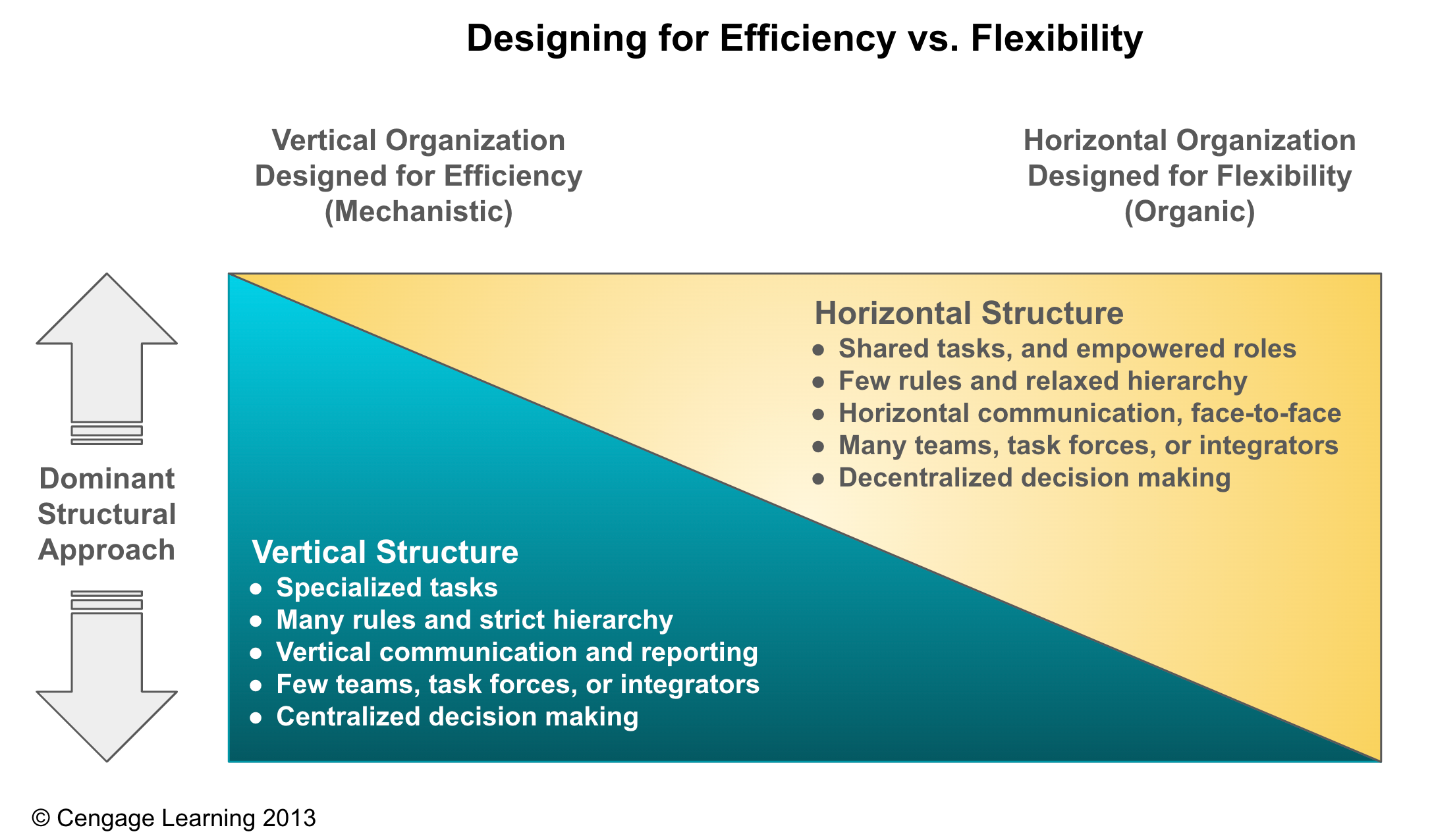
How COO may apply the Organizational Design Process
As outlined above, organization design is not a one size fits all. It depends on the state of several contingencies. In other words the organization is actually designed to fit the contingencies that are present and considered. For example an organization in a stable environment could be effective with a traditional mechanistic structure that emphasizes vertical control, efficiency, specialization, standard procedures, and centralized decision making. However this organization may not have the flexibility and agility to adapt to a rapidly changing environment. A more flexible, organic structure, with collaboration, horizontal information flow/collaboration and decentralized decision making may be more successful in this environment.
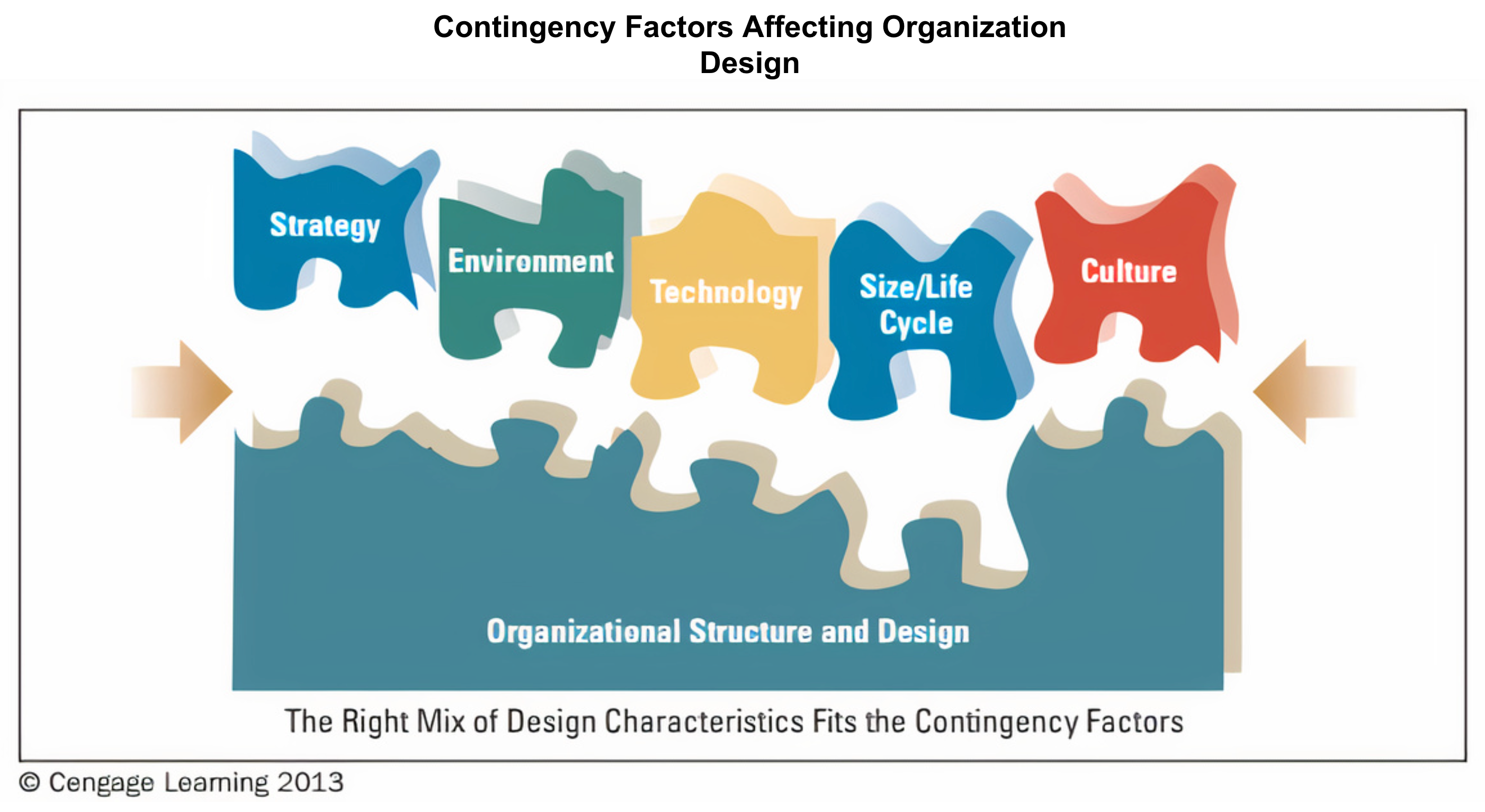
A successful organization design (or re-design) initiative is a highly collaborative approach that impacts the whole organization. The COO will not perform this alone. Although he or she is likely to lead the execution and implementation phases through change management, the leadership team will need to develop a plan from the beginning that covers the following process, at a minimum.
- Set a clear business strategy
- Define how effectiveness will be measured
- Review results and make adjustments
Setting a clear Business Strategy
It starts with setting the business objectives and goals. Often the Chief Executive Officer (CEO), the COO and other top managers perform a SWOT analysis which will be used to define the mission and the purpose of the organization.
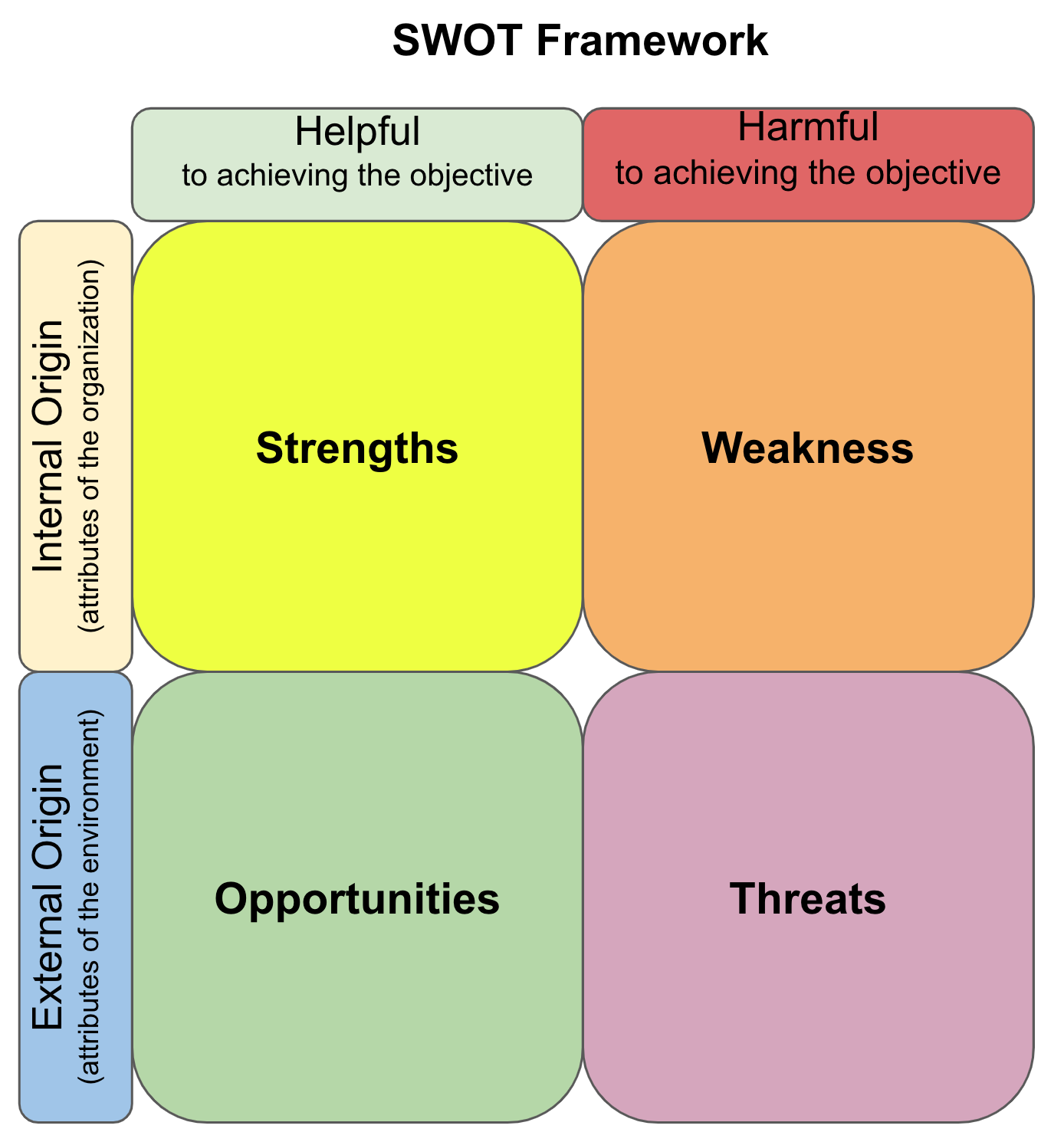
The purpose combined with overall organizational goal, the operational goals and the organization’s strategy creates what may be referred to as the strategic intent or business plan. The Organization design process continues by assessing the contingencies against the internal and external environment of the organization, and designing the organization which management thinks is likely to yield the most effective outcomes.
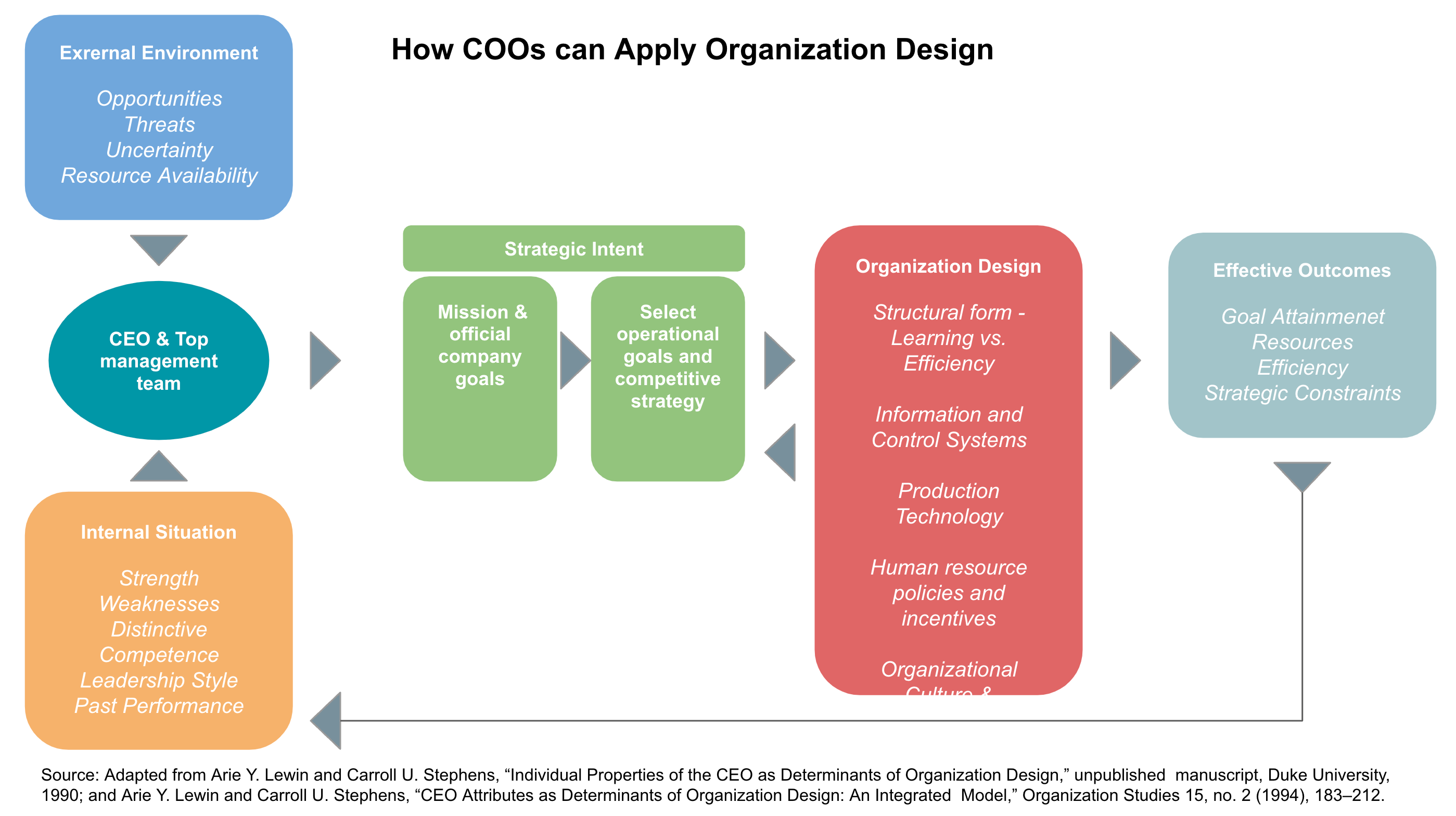
Defining how to measure effectiveness
Next, defining and agreeing on how effectiveness will be measured. Effectiveness has several measurement metrics. Four that are common are:
- Goals
- Resource Acquisition
- Internal Process Efficiency
- Stakeholder Satisfaction/Strategic Constituents
Goals
The goals approach to effectiveness is a straightforward process of setting a goal and measuring the progress toward the goal. This is logical to organizations because every organization tries to attain certain level of productivity, client satisfaction, revenue or profit.
Resource Acquisition
The resource-based approach looks at the input side of common input-conversion-output process. It presumes organizations need to have the best resources to be effective. This could mean, financing, top talent, or best suppliers and vendors to maintain a competitive advantage.
Internal Process Efficiency
The internal process approach measures effectiveness by how smoothly the organization runs. This is not the same as how agile or responsive it is. It means that all the departments work well together, communicate well, with few or no errors, mistakes or down-time when working. The activities of the departments mesh seamlessly with one another.
Stakeholder Approach
The Stakeholder approach measures effectiveness by focusing on the degree to which key stakeholders are satisfied. Key stakeholders are those who are critical to the organization’s ability to survive and thrive. This may include employees, the board of directors, financial and government institutions, and customers.
Reviewing the results and making adjustments
Lastly, organizational design and organizational redesign are iterative processes. At intervals the COO needs to assess how effective the organization is performing and make adjustments to the organizations design, as necessary. Lessons will be learned during the execution phase of the process and applying the lessons learned internally to improve performance, and possibly implementing new systems of operations is an integral part that leads to a culture of continuous improvement. A few iterations of this will transform the organization into a new organization.
Conclusion
Organization Design is a way of thinking about organizations and how to create a system that will help the organization achieve it’s purpose. The fundamentals have been derived from general patterns and regularities learned as Organization Design Scholars have studied organizations. It is a process with interdependent structural dimensions (principles) and contingency factors that create a continuum/sliding scale of different types of organizations. The four structural dimensions (principles) are formalization, specialization, hierarchy of authority, and centralization. The five contingency factors are size and lifecycle, technology, external environment, goals and strategy, and culture. At the extremes of the continuum are two idealistic structures which are the mechanistic structure and the organic structure. In ‘general’, a mechanistic design means that the organization is characterized by machine-like standard rules, procedures, and a clear hierarchy of authority. In contrast an organic design means that the organization is much looser, free-flowing, and adaptive. Rules and regulations aren’t written and are applied with discretion and flexibility. Although it is unlikely to have an idealistic organization, COOs can use the Organization design process and his or hers understanding of the Mechanistic and Organic structures as a guide to identify the current design of his or her organization and develop a road map for creating the most effective organization to allow the company to achieve its goals.
Bonus – List of industries that favor mechanistic or organic structures
Please take note that a comprehensive analysis was not performed for this list!
This is a list that can be used as a guide for understanding how and why some industries are structured as they are. Note that while these industries may generally benefit more from one type of structure, the actual structure that is most effective for a specific organization within the industry will depend on the contingency factors discussed above.
Favoring Mechanistic Structure
Industries that require high levels of standardization, consistency, and control are best suited for a mechanistic structure. Such industries can benefit from a formal approach that enables them to maintain a high level of efficiency and predictability in their operations.
- Manufacturing: The mechanistic structure is widely used in manufacturing industries where standardization, efficiency, and consistency are critical. This includes industries such as automobile manufacturing, electronic goods manufacturing, and aerospace manufacturing.
- Logistics: The logistics industry relies heavily on a mechanistic structure to ensure efficient and timely delivery of goods. The industry involves complex processes and requires the coordination of multiple stakeholders, making a mechanistic structure essential to ensure smooth operations.
- Fast food: Fast-food chains such as McDonald’s and Burger King rely on a mechanistic structure to ensure that the same quality of food and service is provided across all their outlets worldwide. This requires a high level of standardization and consistency in their operations.
- Retail: Retail industries such as Walmart and Target use a mechanistic structure to maintain consistency in their operations, manage large volumes of products, and ensure timely delivery to their stores.
- Banking and Finance: Banks and financial institutions require strict controls, standardization, and consistency in their operations, making a mechanistic structure essential.
- Construction: Construction companies use a mechanistic structure to manage large projects, ensure consistency in their operations, and meet deadlines.
- Airlines: Airlines require a high level of standardization and consistency in their operations, making a mechanistic structure essential to ensure timely departures, arrivals, and safety.
- Telecommunications: Telecommunication companies use a mechanistic structure to manage complex networks, ensure service quality, and maintain regulatory compliance.
- Government: Many government agencies, such as tax departments and transportation authorities, rely on a mechanistic structure to manage complex operations, ensure consistency in their services, and maintain transparency.
- Military: The military uses a mechanistic structure to maintain strict hierarchy, standardization, and control over operations.
Favoring Organic Structures
Industries that perform best with an organic structure tend to be those that require a high degree of innovation, creativity, and flexibility to succeed. These industries often value collaboration, experimentation, and a culture of continuous learning and improvement.
- Technology: Technology companies are known for their fast-paced, innovative work environments that value creativity and flexibility. Examples include software development, internet services, and electronics manufacturing.
- Nonprofits: Nonprofit organizations often have a strong mission-driven culture that values collaboration and community involvement. An organic structure can encourage more creative approaches to problem-solving and community engagement.
- Hospitality: The hospitality industry is highly customer-focused, with an emphasis on providing unique and personalized experiences. An organic structure can allow for more creativity and collaboration in developing new service offerings and guest experiences.
- Fashion: The fashion industry is highly competitive and constantly changing, with new trends emerging all the time. An organic structure can allow for more flexibility and experimentation in designing and producing new fashion lines.
- E-commerce: E-commerce businesses operate in a highly competitive and rapidly evolving market, with new products and services being launched all the time. An organic structure can allow for more nimble decision-making and experimentation with new business models.
- Architecture and design: The architecture and design industry often requires a high degree of innovation and creativity in developing new building designs and spaces. An organic structure can encourage collaboration and experimentation to develop innovative solutions.
- Food and beverage: The food and beverage industry is highly consumer-driven, with new trends and preferences emerging regularly. An organic structure can allow for more flexibility and creativity in developing new products and experiences.
- Media and entertainment: The media and entertainment industry is constantly evolving with new technologies and platforms emerging regularly. An organic structure can encourage innovation and experimentation in developing new content and experiences.
- Social impact: Social impact organizations work to address societal challenges and often require a high degree of collaboration, experimentation, and creativity to achieve their goals. An organic structure can encourage innovation and creativity to develop new solutions and approaches.
- Gaming: The video game industry is constantly evolving with new technologies, platforms, and gaming trends. An organic structure can encourage innovation, creativity, and a culture of experimentation.


